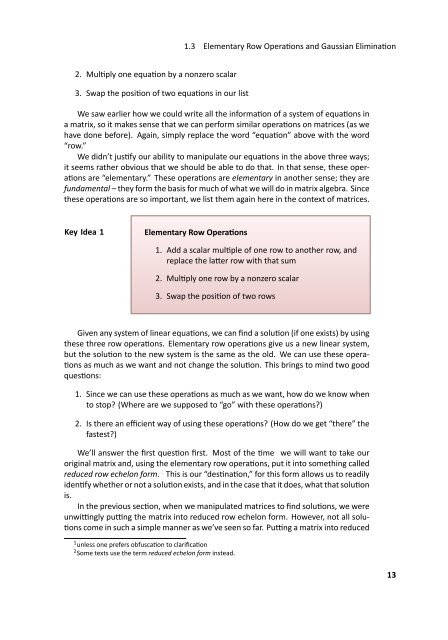Fundamentals of Matrix Algebra, 2011a
Fundamentals of Matrix Algebra, 2011a
Fundamentals of Matrix Algebra, 2011a
You also want an ePaper? Increase the reach of your titles
YUMPU automatically turns print PDFs into web optimized ePapers that Google loves.
1.3 Elementary Row Operaons and Gaussian Eliminaon<br />
2. Mulply one equaon by a nonzero scalar<br />
3. Swap the posion <strong>of</strong> two equaons in our list<br />
We saw earlier how we could write all the informaon <strong>of</strong> a system <strong>of</strong> equaons in<br />
a matrix, so it makes sense that we can perform similar operaons on matrices (as we<br />
have done before). Again, simply replace the word “equaon” above with the word<br />
“row.”<br />
We didn’t jusfy our ability to manipulate our equaons in the above three ways;<br />
it seems rather obvious that we should be able to do that. In that sense, these operaons<br />
are “elementary.” These operaons are elementary in another sense; they are<br />
fundamental – they form the basis for much <strong>of</strong> what we will do in matrix algebra. Since<br />
these operaons are so important, we list them again here in the context <strong>of</strong> matrices.<br />
. Key Idea 1 Elementary Row Operaons<br />
1. Add a scalar mulple <strong>of</strong> one row to another row, and<br />
replace the laer row with . that sum<br />
2. Mulply one row by a nonzero scalar<br />
3. Swap the posion <strong>of</strong> two rows<br />
Given any system <strong>of</strong> linear equaons, we can find a soluon (if one exists) by using<br />
these three row operaons. Elementary row operaons give us a new linear system,<br />
but the soluon to the new system is the same as the old. We can use these opera-<br />
ons as much as we want and not change the soluon. This brings to mind two good<br />
quesons:<br />
1. Since we can use these operaons as much as we want, how do we know when<br />
to stop? (Where are we supposed to “go” with these operaons?)<br />
2. Is there an efficient way <strong>of</strong> using these operaons? (How do we get “there” the<br />
fastest?)<br />
We’ll answer the first queson first. Most <strong>of</strong> the me 1 we will want to take our<br />
original matrix and, using the elementary row operaons, put it into something called<br />
reduced row echelon form. 2 This is our “desnaon,” for this form allows us to readily<br />
idenfy whether or not a soluon exists, and in the case that it does, what that soluon<br />
is.<br />
In the previous secon, when we manipulated matrices to find soluons, we were<br />
unwingly pung the matrix into reduced row echelon form. However, not all solu-<br />
ons come in such a simple manner as we’ve seen so far. Pung a matrix into reduced<br />
1 unless one prefers obfuscaon to clarificaon<br />
2 Some texts use the term reduced echelon form instead.<br />
13

















